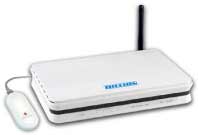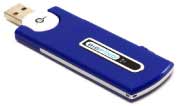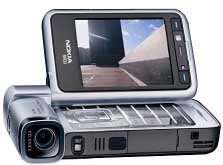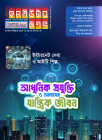হোম > Era of Mobile Broadband
লেখক পরিচিতি
লেখকের নাম:
ঈদাত অপূর্বা সিংহা
মোট লেখা:৯
লেখা সম্পর্কিত
পাবলিশ:
২০০৮ - সেপ্টেম্বর
তথ্যসূত্র:
কমপিউটার জগৎ
লেখার ধরণ:
মোবাইল
তথ্যসূত্র:
ইংরেজি সেকশন
ভাষা:
বাংলা
স্বত্ত্ব:
কমপিউটার জগৎ
Era of Mobile Broadband
Its not a fairytale but also a real phenomenon that systematically has changed our lifestyle. Yes, I talk about the smart amazing gadget commonly known as cell phone that virtually eliminates all communication barriers and make people ubiquitous.

Needless to say, proliferation of cell phones emulates the dominance of personal computers (PCs). Nowadays cell phone is not only limited to voice communication rather it is capable to provide solution to all communications and entertainment requirements.
Worldwide chronological increment of cell phone subscribers drives mobile network operators to diverse their service portfolio. As a result, it triggers the necessity to upgrade existing technology and develop more innovative content.

Due to this trend of mobile industry the mobile broadband technology came into limelight. The term mobile broadband reveals new age of mobile communication that popularly known as 3G (third generation). The 3G system basically brings ample opportunities for the mobile users as it paves the way to enjoy high speed internet, rich multimedia contents and ensure clear voice communication.

A report by Pew Internet & American Life Project revealed that 58 percent of all Americans have used a cell phone or PDA for data incentive activities such as sending an email and enjoy audio visual content. The report also claimed that 41 percent of all Americans have used a Wi-Fi enabled laptop or other mobile device to access the interent from any place at any instant.
The cellular telecommunication system is technically divided into two distinct categories such as GSM (Global System for Mobile Communications) and CDMA (Code Division Multiple Access). GSM networks are common in Europe and Asia, whereas CDMA in United States. These two systems function differently to share space on the radio spectrum.
Mobile broadband is a 3G system and both GSM and CDMA have developed their own 3G technology solutions to provide high-speed internet access to mobile devices.

EV-DO (Evolution-Data Optimized or Evolution-Data Only) is the 3G solution from CDMA based mobile broadband technology. The operational tactics of EV-DO is it runs over a part of the cellular network devoted entirely to data. Generally, voice calls require significant portion of available bandwidth in order to retain the voice quality.
By separating the data channel from the voice channel, the network can maximize data transfers and provide optimum speed to access Internet and multimedia contents. In this regard, the main setback is subscriber cant access the Internet or other data services when talking on the phone. EV-DO claimed its speed ranging from 300kbps to 400kbps equivalent to DSL.
There are two ways to enjoy the services of EV-DO network. First one is, a subscriber need to purchase a device (BlackBerry or other smartphones) that incorporated EV-DO technology. Second one is, special network card that a subscriber needs to connect to his/her laptop via USB ports or other standard PC card slots. In order to get the high speed download and upload speed a subscriber needs to calibrate his/her position within the range of EV-DO cellular signal. Otherwise the speed downgrade to 1XRTT (Radio Transfer Technology) standard, which broadcasts at speeds between 60 and 100kbps.
GSM equivalent to EV-DO is HSDPA (High Speed Downlink Packet Access). Unlike EV-DO, HSDPA allows subscriber to talk and surf the web simultaneously. As the name implies HSDPA maximizes data transfer speed by concentrating on downloading information instead uploading. HSDPA technology claimed average download speeds from 400 to 700 kbps.
Resembles EV-DO, HSDPA also requires device with a built-in HSDPA card or a special PC card that plugs into the laptop. Data transfer rate remains high within the strong signal range of HSDPA network. Devices that are require to access mobile broadband network are 3G cell phone, PDA/smartphone, laptop computer with a PC card, laptop computer using a cell phone as a modem etc.
In the European market major mobile broadband players are 3, T-Mobile, Orange, Vodafone and O2. In the United States, three large cellular-service providers offer mobile broadband services on their networks. Sprint and Verizon are both CDMA networks and they offer EV-DO solution. On the contrary, AT&T, formerly Cingular, is a GSM network, so its offering an HSDPA mobile broadband service. In Asia-Pacific region 3G wireless service is available from the operators in Hong Kong, Singapore, Korea, Japan, Australia, Taiwan and New Zealand.
Bangladesh is still in the nascent stage of 3G operation. Recently, countrys telecom regulator BTRC (Bangladesh Telecommunication Regulatory Commission) allocates frequency for six months to Ericsson Bangladesh Limited, a Sweden based telecom equipments manufacturer to demonstrate 3G system on trail basis in the Dhaka region. Ericsson Bangladesh is conducting the trial in collaboration with the mobile network operators such as Grameenphone, AkTEL and Warid Telecom International Ltd.
CJ Web
FeedBack : edward_ict@yahoo.com

Needless to say, proliferation of cell phones emulates the dominance of personal computers (PCs). Nowadays cell phone is not only limited to voice communication rather it is capable to provide solution to all communications and entertainment requirements.
Worldwide chronological increment of cell phone subscribers drives mobile network operators to diverse their service portfolio. As a result, it triggers the necessity to upgrade existing technology and develop more innovative content.

Due to this trend of mobile industry the mobile broadband technology came into limelight. The term mobile broadband reveals new age of mobile communication that popularly known as 3G (third generation). The 3G system basically brings ample opportunities for the mobile users as it paves the way to enjoy high speed internet, rich multimedia contents and ensure clear voice communication.

A report by Pew Internet & American Life Project revealed that 58 percent of all Americans have used a cell phone or PDA for data incentive activities such as sending an email and enjoy audio visual content. The report also claimed that 41 percent of all Americans have used a Wi-Fi enabled laptop or other mobile device to access the interent from any place at any instant.
The cellular telecommunication system is technically divided into two distinct categories such as GSM (Global System for Mobile Communications) and CDMA (Code Division Multiple Access). GSM networks are common in Europe and Asia, whereas CDMA in United States. These two systems function differently to share space on the radio spectrum.
Mobile broadband is a 3G system and both GSM and CDMA have developed their own 3G technology solutions to provide high-speed internet access to mobile devices.

EV-DO (Evolution-Data Optimized or Evolution-Data Only) is the 3G solution from CDMA based mobile broadband technology. The operational tactics of EV-DO is it runs over a part of the cellular network devoted entirely to data. Generally, voice calls require significant portion of available bandwidth in order to retain the voice quality.
By separating the data channel from the voice channel, the network can maximize data transfers and provide optimum speed to access Internet and multimedia contents. In this regard, the main setback is subscriber cant access the Internet or other data services when talking on the phone. EV-DO claimed its speed ranging from 300kbps to 400kbps equivalent to DSL.
There are two ways to enjoy the services of EV-DO network. First one is, a subscriber need to purchase a device (BlackBerry or other smartphones) that incorporated EV-DO technology. Second one is, special network card that a subscriber needs to connect to his/her laptop via USB ports or other standard PC card slots. In order to get the high speed download and upload speed a subscriber needs to calibrate his/her position within the range of EV-DO cellular signal. Otherwise the speed downgrade to 1XRTT (Radio Transfer Technology) standard, which broadcasts at speeds between 60 and 100kbps.
GSM equivalent to EV-DO is HSDPA (High Speed Downlink Packet Access). Unlike EV-DO, HSDPA allows subscriber to talk and surf the web simultaneously. As the name implies HSDPA maximizes data transfer speed by concentrating on downloading information instead uploading. HSDPA technology claimed average download speeds from 400 to 700 kbps.
Resembles EV-DO, HSDPA also requires device with a built-in HSDPA card or a special PC card that plugs into the laptop. Data transfer rate remains high within the strong signal range of HSDPA network. Devices that are require to access mobile broadband network are 3G cell phone, PDA/smartphone, laptop computer with a PC card, laptop computer using a cell phone as a modem etc.
In the European market major mobile broadband players are 3, T-Mobile, Orange, Vodafone and O2. In the United States, three large cellular-service providers offer mobile broadband services on their networks. Sprint and Verizon are both CDMA networks and they offer EV-DO solution. On the contrary, AT&T, formerly Cingular, is a GSM network, so its offering an HSDPA mobile broadband service. In Asia-Pacific region 3G wireless service is available from the operators in Hong Kong, Singapore, Korea, Japan, Australia, Taiwan and New Zealand.
Bangladesh is still in the nascent stage of 3G operation. Recently, countrys telecom regulator BTRC (Bangladesh Telecommunication Regulatory Commission) allocates frequency for six months to Ericsson Bangladesh Limited, a Sweden based telecom equipments manufacturer to demonstrate 3G system on trail basis in the Dhaka region. Ericsson Bangladesh is conducting the trial in collaboration with the mobile network operators such as Grameenphone, AkTEL and Warid Telecom International Ltd.
CJ Web
FeedBack : edward_ict@yahoo.com
লেখাটি পিডিএফ ফর্মেটে ডাউনলোড করুন
পাঠকের মন্তব্য
অনুরূপ লেখা


